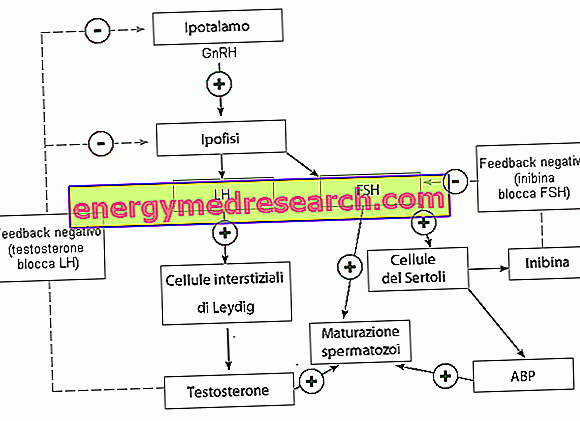What are
As the name suggests, gonadotropins are hormones that can regulate the activity of the gonads or, more simply, the functions of male and female reproductive organs.
The most known gonadotropins are two, called, respectively, LH ( luteinizing hormone ) and FSH ( follicle stimulating hormone ); this time, however, the interpretation of their names could be misleading, since, while referring to the activity of the ovaries, they are also active on the testicles.
Secretion
Gonadotropins are secreted by the anterior pituitary or adenohypophysis, a small gland the size of a bean located at the base of the skull. Its activity is controlled by a region of the brain called the hypothalamus, through a fine regulatory mechanism that uses hormonal substances. Among these, the main one is the GnRH peptide (from the English gonadotropin-releasing hormone), which favors the release of gonadotropins.
Once secreted, being of a glycoprotein nature, LH and FSH are transported from the blood to the target cells, where there are specific membrane receptors waiting for them. Interacting with them, they trigger a series of biochemical and metabolic events that differ according to the organ concerned.
Functions
Gonadotropins regulate testicular activity in men and ovarians in women.
In the Woman
| STIMULATING FOLLICLE HORMONE (FSH) | LUTEINIZING HORMONE (LH) |
This gonadotropin induces the maturation of ovarian follicles, which are nothing more than egg cells surrounded by follicular cells. During the fertile period of the woman, approximately every 28 days, an ovarian follicle is brought to maturity. As it develops it produces estrogen, hormones important for regulating the fertility of women. | It stimulates testosterone production by theca cells, which is then readily converted to estrogen by granulosa cells. Both of these cells are part of the ovarian follicle: the outermost layer is made up of cells of the theca, the innermost one by granulosa cells. LH also stimulates ovulation, that is the release from the follicle of the mature egg cell, which at this point can - at least theoretically - be fertilized. The residual corpus luteo will instead produce progesterone, an important hormone to guarantee the possible implantation of the fertilized egg and support the pregnancy. |
In humans
| STIMULATING FOLLICLE HORMONE (FSH) | LUTEINIZING HORMONE (LH) |
This gonadotropin favors, in humans, spermatogenesis, the process that leads to the formation and maturation of spermatozoa. | It stimulates testosterone production by testicular interstitial cells (called Leydig cells). For this reason, in the male, the luteinizing hormone takes the name ICSH (acronym of Interstitial Cell Stimulating Hormone). |

HCG
In addition to the luteinizing hormone (LH) and the follicle stimulating hormone (FSH), a third hormone, called human chorionic gonadotropin (HCG), is also included in the gonadotropin category. This substance is secreted by particular cells of the placenta during pregnancy, with the aim of prolonging the stimulating effect of the hormone LH on the synthesis of progesterone by the corpus luteum.
Medical applications
In therapy, gonadotropins are used to stimulate the production of sex hormones in both males and females and / or to increase fertility.
The dosage of Human Chorionic Gonadotropin, performed on urine or blood, is used as a pregnancy test. This gonadotropin is also administered in the sports field to reactivate testicular testosterone production (for example after taking high-dose anabolic steroids).



